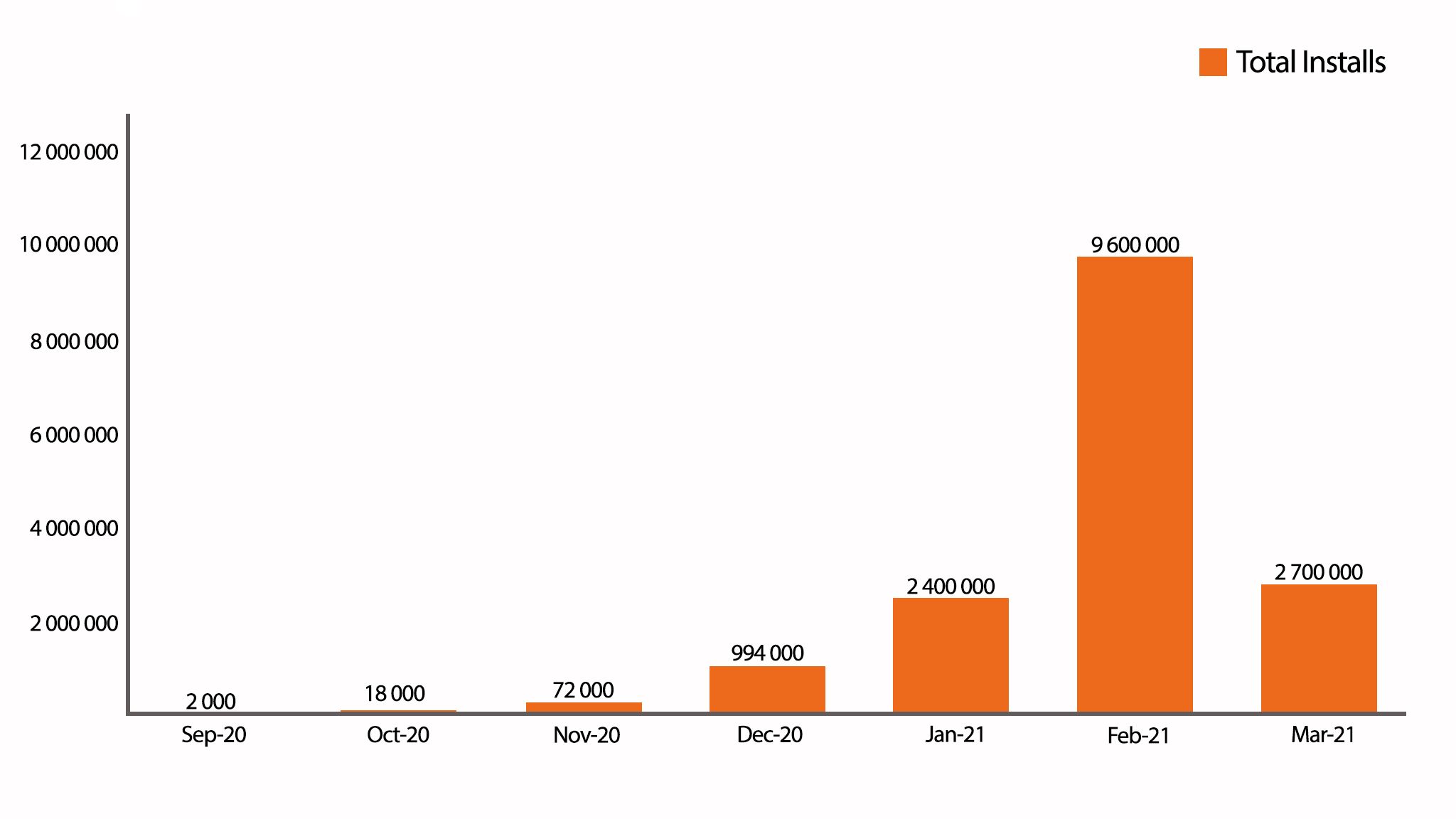
The most talked-about social media platform of the year recently added donations for room owners, while third-party applications also provide monetization on the platform. However, the formats are still limited by influence marketing, and the audience growth rate has slowed down. Let’s see why it is too early for businesses and marketers to go to the Clubhouse and whether this could change.
Last spring, no one had heard of Clubhouse, and just a year, before the upcoming IPO, Bloomberg already estimated the company’s value at $4 billion, which is only a few billion less than Discord and Reddit.
These numbers undoubtedly show interest from investors, which is not surprising when you look at the audience growth rate. According to Sensor Tower, more than 16 million users worldwide have downloaded the app since the beginning of 2020. Moreover, the highest growth was observed in February of this year: 9.6 million people vs. 2.4 million in January 2021 and one million in December 2020.
What’s Clubhouse?
If you somehow managed to miss such an event, we’ll explain. Clubhouse is a social network launched in spring 2020 by Paul Davidson and Rohan Seth. The platform audience can communicate in audio format in special rooms. Each user has the ability to open their own room. Until now, only iPhone owners had access to the application, which they gained only by invitations of already registered users.
Just the other day, the platform has finally released the long-awaited beta version for Android.
The growth rate is impressive, considering that from the start, the app installation was available only to iPhone owners. It’s impressive, but it doesn’t answer the much more important question of what benefits it can bring to your business.

Clubhouse for creators: Monetization opportunities
For marketers and brands, there are already some opportunities, but they are limited. In early April, Clubhouse launched its first monetization feature, Clubhouse Payments, which allows sending tips to room owners. As noted in the blog, “Payments will be the first of many features that allow creators to get paid directly on Clubhouse.”
This news is important for the market and highlights two points: first, the app owners plan to further develop monetization opportunities on the platform, and second, the main emphasis is planned on supporting and developing influencer marketing.
The second that the platform plans to actively work with room owners is the Creator First Program competition launched in March. In early May, Clubhouse summed up the first stage of the program and announced plans to support the winners with resources and share them on their social media pages and blog.
While Clubhouse is working on built-in monetization mechanisms, many startups are entering the market and intend to take on the role of an intermediary between businesses and room owners. For example, DigiDay writes about Clubmarket, a third-party application for transactions between brands and influencers. Officially, the company has nothing to do with the platform; it only takes on the role of an intermediary by connecting advertisers with influencers manually.
This news proves that marketers are still quite limited in the formats they can offer to businesses. As for business, companies may already be present on the platform, but it is not clear in what format and what benefits they receive.

What can a business do now on Clubhouse?
Given what the platform and third-party applications offer, the business has the following presence formats:
- Branded rooms;
- Purchase of direct advertising from influencers;
- Room sponsorship;
- Participation of brand representatives in discussions.
What’s wrong with Clubhouse audience data?
User growth has slowed down. According to Sensor Tower, the app’s downloads fell from 9.6 million to 2.7 million in March. That is, the number of new installations dropped down by almost 73%.
Clubhouse statistics do not include important details. So far, all the data operated by the market belong to third-party analysts, while Clubhouse remains silent. Neither brands nor marketers still know anything about the socio-demographic characteristics of users. This can only be judged indirectly. For example, the CivicScience report for the US market shows that 79% of respondents over the age of 18 have never heard of this social network. It turns out that younger users may be present on the platform, but it remains unclear whether these numbers are relevant for other markets. However, only official data will help to clarify.
Do not overestimate the size of your audience. 16 million users sounds impressive, especially considering that such a number of downloads was recorded in just a year. However, let’s look at the We Are Social study of the audience of the largest social media platforms in 2020. The number of active Facebook users per month is 2.7 billion people. Well, except for popular messengers, the monthly active audience of platforms such as Instagram, TikTok, and Twitter is 1.2 billion, 690 million, and 350 million, respectively.
Reasons for Clubhouse’s popularity
Many attributed the rise of the Clubhouse to the growing interest in the audio format in general. So, according to eMarketer, in the United States in 2021, the number of podcast listeners will increase by 16% to 106 million per year.
The second popular reason is that people yearned for communication during self-isolation, and Clubhouse became the perfect outlet. It simultaneously allows communication and is completely different from Zoom, Skype, and other video conferencing services that people are tired of.
Others see the service popularity reasons in the competent strategy of managers: Elon Musk, Mark Zuckerberg, Oprah Winfrey, and other opinion leaders were the first who receive the Clubhouse invitations. In addition, the platform structure assumes that everyone has a theoretical opportunity to either communicate with their own idols or see a new side of them during informal communication as listeners. The elitism of the community also played a role because it was possible to join the platform only by invitation.
One way or another, Clubhouse entered the market at just the right time and revealed an unexpected demand for communication in audio format.

What’s the bottom line?
Based on the monetization feature that has appeared on the platform, Clubhouse plans to focus on working with influencers. Accordingly, for business, this means the dominance of influencer marketing opportunities. And even in the case, a brand appears on the platform, the service still lacks data on conversion and user behavior.
Anyway, the prospects for the service are still clouded, the audience is small, and there is a lack of both the variety of tools for influencers and personal business opportunities. This may change after launching the app on Android, but so far we are only seeing a bubble has grown by user interest that could burst at any moment.
Finally, the competition with larger market players introduces the main uncertainty in the future of Clubhouse. Discord, LinkedIn, Facebook, and Twitter, one after another, announced the creation of similar functionality based on their own platforms.
In this regard, Discord, LinkedIn, Facebook, and Twitter look much more reliable. Information about the audience is available in the social networks themselves, while it is possible to get detailed data about the audience of any accounts through third-party business services, for example, through social media cross-posting services such as Postoplan.











